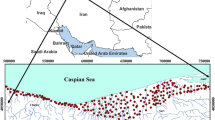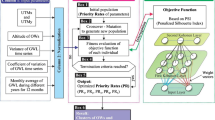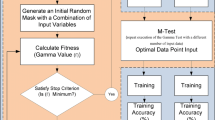Abstract
Using the MATLAB™ platform, groundwater quality in Jilin, China, is evaluated by employing integrated- and automation-type models. Genetic algorithm (GA), particle swarm optimisation, and support vector machine (SVM) theory are coupled in the model to form two-layer loop nesting. By using a GA, the surrounding loop enters the inner loop by choosing some factors from all measured evaluation factors. The inner loop is mainly composed of the SVM model. The inner loop feeds back the fitness function value of the GA obtained by weighting the model classification accuracy, and the reduced dimensions of each evaluation factor, to the surrounding loop. This aims to adjust the direction of evolution of the GA and eliminate evaluation factors with redundant, or sparse, information. The established model is applied to evaluate groundwater quality in Jilin and reduces 16 original evaluation factors to nine through a dimensionality reduction method. The training and verification sets constructed in the model exhibit more than 95% accuracy. Among the 183 wells used for monitoring groundwater in Jilin, the numbers of I-, II-, III-, IV-, and V-type monitoring wells are two, 96, 61, 20, and four, respectively. Compared with ordinary methods of evaluating water quality, the method integrates data selection and data processing instead of performing it in two successive substeps. The method exhibits the significant effect of dimensionality reduction on the number of its evaluation factors and also shows accurate evaluation results for water quality samples. Moreover, the method’s ability to be applied in many conditions provides a good basis for its use in various classification problems including water quality evaluation.











Similar content being viewed by others
References
Alavipoor FS, Fatemeh S, Ghorbaninia Z et al (2016) Surface water contamination risk assessment modelled by Fuzzy-Wrastic. Water Environ Res 88(7):589–601
Arabgol R, Sartaj M, Asghari K (2016) Predicting nitrate concentration and its spatial distribution in groundwater resources using support vector machines (SVMs) model. Environ Model Assess 21(1):71–82
Chu HB, Lu WX, Zhang L (2013) Application of artificial neural network in environmental water quality assessment. J Agric Sci Technol 15(2):343–356
Dahiya S, Singh B, Gaur S et al (2007) Analysis of groundwater quality using fuzzy synthetic evaluation. J Hazard Mater 147(3):938–946
Dibike YB, Velickov S, Solomatine D et al (2001) Model induction with support vector machines: introduction and applications. J Comput Civ Eng 15(3):208–216
Farmaki EG, Thomaidis NS, Nikolaos S et al (2013) Comparative use of artificial neural networks for the quality assessment of the water reservoirs of Athens. J Water Supply Res Technol Aqua 62(5):296–308
Huang H, Liang XJ, Xiao CL et al (2015) Analysis and assessment of confined and phreatic water quality using a rough set theory method in Jilin City, China. Water Sci Technol- Water Supply 15(4):773–783
Liu Y, Wang HF, Zhang H et al (2016) A comprehensive support vector machine- based classification model for soil quality assessment. Soil Tillage Res 155:19–26
Maier HR, Morgan N, Chow CWK (2004) Use of artificial neural networks for predicting optimal alum doses and treated water quality parameters. Environ Model Softw 19(5):485–494
Olness A (1995) Water quality: prevention, identification and management of diffuse pollution. J Environ Qual 24(2):383–383
Palacio SM, Espinoza Q, Fernando R et al (2016) Assessment of Anthropogenic impacts on the water quality of Marreco river, Brazil, based on principal component analysis and toxicological assays. Water Air Soil Pollut 227(9):307–317
Pawlak Z (1997) Rough set approach to knowledge-based decision support. Eur J Oper Res 99(1):48–57
Sen Z (2009) Global warming threat on water resources and environment: a review. Environ Geol 57(2):321–329
Stoichev T, Tessier E, Amouroux D et al (2016) Multiple regression analysis to assess the role of plankton on the distribution and speciation of mercury in water of a contaminated lagoon. J Hazard Mater 318:711–722
Viala E (2008) Water for food, water for life a comprehensive assessment of water management in agriculture. Irrigat Drain Syst 22(1):127–129
Vlachokostas C, Achillas C, Chourdakis E et al (2011) Combining regression analysis and air quality modelling to predict benzene concentration levels. Atmos Environ 45(15):2585–2592
Wei RC, Xiao CL, Liang XJ (2014) Spatio-temporal evolution of groundwater pollution in the urban areas of Jilin City. China Environ Sci 34(2):417–423
Zhou YH, Wei AH, Li JF et al (2016) Groundwater quality evaluation and health risk assessment in the Yinchuan region, Northwest China. Exposure Health 8(3):443–456
Acknowledgements
This work was financially supported by the Scientific Research Initiation funds for PhD scholars (BQ2017011); China’s Post-doctoral Science Fund (2018M631874); Scientific Research Projects of the Higher University in Hebei (ZD2019082); Hebei Province Water Conservancy Science and Technology Plan Projects (2017-59); Youth Foundation of Hebei Province Department (QN2017026); Natural Science Fund Project in Hebei Province (D2018403040); and Hebei Key Laboratory of Geological Resources and Environmental Monitoring and Protection Fund (JCYKT201901).
Author information
Authors and Affiliations
Corresponding author
Additional information
Publisher's Note
Springer Nature remains neutral with regard to jurisdictional claims in published maps and institutional affiliations.
Rights and permissions
About this article
Cite this article
Yan, B., Yu, F., Xiao, X. et al. Groundwater quality evaluation using a classification model: a case study of Jilin City, China. Nat Hazards 99, 735–751 (2019). https://doi.org/10.1007/s11069-019-03770-6
Received:
Accepted:
Published:
Issue Date:
DOI: https://doi.org/10.1007/s11069-019-03770-6




